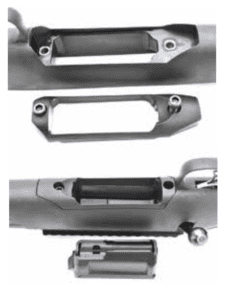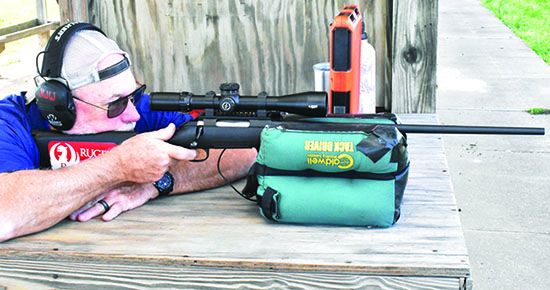The current “cool” trend among rifle enthusiasts seems to be long-range disciplines. Especially for the PRS game, 6mm rifles rule. Those chamberings offer good downrange performance, the ability to buck the wind well, and to do so with recoil light enough to allow the shooters to spot their hits and misses. We talked to the folks at RCBS recently, and they confirmed the popularity of the likes of the 6 Dasher, 6 BR, 6 BRA, and 6 Creedmoor chamberings in their competition die sales. Interestingly, the most famous of all the 6mms, the 243 Winchester, is conspicuously absent from that list. At least, that is, until you look at their sales of hunting-class dies, and then the 243 is in the top ten.
Some of our readers who hunt told us that they wanted to hear about rifles chambered in 243, so here we go. While we wanted to take a look at four quality rifles, we wanted to pick a quartet that wouldn’t break the bank. Our first selection is the Savage/Stevens Model 334 as imported from Turkey. Selling for a mere $425, this rifle sports a three-lug bolt and a real Turkish walnut stock. Next in line is the Savage Model 110, $760, with the outstanding Accustock and a trigger that was appreciated by this group of trigger snobs. Third is another rifle for the budget-minded in the guise of a Ruger American, $442. Batting cleanup is the Weatherby Vanguard First Lite, $923, the most expensive rifle in this test by a factor of two over the Ruger and the Stevens. The First Lite arrived with a camouflaged stock, Cerakoted action, fluted barrel, and a muzzle brake. It looks great, but was the shooting worth the extra cash? Let’s find out.
Ruger American 6904 243 Winchester
$442
Gun Tests grade: A- (BEST BUY)
The most accurate rifle in the group by a narrow margin, the Ruger American performs at a level above what the price would suggest. It was the lightest in this group, so it would carry well. We would have liked for the rifle to have a threaded muzzle for attachment of a brake or suppressor.

| Action Type | Bolt, 2 lugs |
| Overall Length | 42.0 in. |
| Barrel | 22.0 in. long, 1:9 twist, matte-black steel |
| Overall Height | 6.5 in. |
| Weight Unloaded | 6.2 lbs. |
| Weight Loaded | 6.7 lbs. |
| Action | Matte-black steel |
| Magazine | 4-round detachable polymer box |
| Stock | Black synthetic, Power Bedding |
| Stock Drop at Comb | 0.5 in. |
| Stock Drop at Heel | 0.5 in. |
| Stock Buttplate | Soft Rubber |
| Stock Length of Pull | 13.75 in. |
| Receiver Scope-Base Pattern | Picatinny rail |
| Trigger Pull Weight | 3.6 lbs. |
| Safeties | Tang, trigger |
| Warranty | None written |
| Telephone | (336) 949-5200 |
| Website | Ruger.com |
| Made In | U.S. |
Sturm, Ruger & Company has long had the reputation of producing good products at an affordable price. We realize that “affordable” is relative, but look at some of the things they’ve done. The 10/22 rifle is one of the best-selling rimfires of all time, with a starting price well under $300. Go to a Single Action Shooting Society match and see how many of the competitors are using Ruger single action pistols. Also, Ruger has recently improved and reintroduced the 1894 Marlin.
Since it was rolled out in 2012, the Ruger American Rifle has continued in that tradition. We’ve frequently heard the comment that the American Rifle “punches above its weight.” We wanted to see if a 243-chambered version could do the same thing.
The injection-molded stock won’t win any beauty contests, but it does its job well. Ruger doesn’t use glass bedding or many of the traditional methods for attaching the stock to the action. Instead, a process Ruger calls “Power Bedding” places two V-shaped steel blocks in the stock that are wedged under the receiver as the action screws are tightened. Also functioning as recoil lugs as well as pillars, the blocks secure the action to the stock and allow the barrel to be free floated.

On the exterior, the stock includes raised panels at the fore end and the wrist, along with a soft-rubber buttpad. The bottom of the stock has the expected two sling-swivel studs and a red Ruger dragon. The trigger guard is molded in with the rest of the stock. The detachable rotary magazine is held by a housing that can be switched out dependent on the rifle’s caliber. For example, the 223 Remington and 300 Blackout versions use a different housing that accepts AR-style magazines. Magazine release is accomplished via a latch at the front end of the magazine. The latch is protected from inadvertent activation.
The action does its part to keep the weight down, too. We measured the muzzle diameter at 0.575 inch, which matched the profile of the rest of the trim barrel. The receiver has flats milled on the sides to remove a bit more metal. That said, the ejection port is a relatively small opening, leaving the action solid on top and very rigid. Stiff actions contribute to accuracy, and the Ruger American is certainly accurate. Ruger includes a low-mount 0-minute-of-angle (MOA) Picatinny rail for scope mounting.
The bolt is released via a pivoting lever on the left side of the receiver. It is a full-diameter unit with three lugs. That provides a 70-degree lift and keeps the bolt handle (which is easy to change) well clear of low-mounted scopes. Dual cocking cams provide even more assistance in the bolt lift. For shell removal, the Ruger American uses a spring-loaded plunger and a sliding-plate extractor located in one of the lugs. The safety is a two-position thumb switch mounted very conveniently on the tang. For the Southpaws out there, Ruger chambers the American rifle for left-handed shooters in a variety of calibers.
Our preference on good triggers is to have one that allows you to put enough pressure on the trigger blade to know that we are touching it without immediately setting it off. That translates to a trigger-break weight somewhere between 2 and 2.5 pounds. This Ruger American broke consistently at about 3.6 pounds — but it felt a bit lighter. The Ruger Marksman Adjustable unit installed helps a great deal. We can still feel just a bit of flex as we tighten our finger on the trigger, but it breaks smoothly and cleanly. Marketed as adjustable between 3 and 5 pounds, we left ours where it was.
Our Team Said: With an average group size of 0.98 inch across three different types of ammo, the American was the most accurate in this group. It showed a very real preference for the Black Hills 95-grain SST load, with an average under 0.75 inch and a best group smaller than 0.5 inch. The rifle’s bolt throw was smooth from the first time we worked it. With the wild popularity of muzzle brakes and suppressors today, we would love to see Ruger thread the muzzle and allow for easy attachment of these devices. That’s our sole ding on the rifle.
| 243 WINCHESTER RANGE DATA | ||||
| Barnes VOR-TX 80-grain TTSX BT | Ruger American | Savage Model 110 | Stevens Model 334 | Weatherby Vanguard |
| Average Velocity | 3166 fps | 3222 fps | 3126 fps | 3416 fps |
| Muzzle Energy | 1781 ft.-lbs. | 1844 ft.-lbs. | 1736 ft.-lbs. | 2073 ft.-lbs. |
| Average Group | 1.13 in. | 0.78 in. | 0.70 in. | 0.71 in. |
| Best Group | 1.21 in. | 0.91 in. | 0.97 in. | 0.96 in. |
| Sierra Gamechanger 90-grain TGK | Ruger American | Savage Model 110 | Stevens Model 334 | Weatherby Vanguard |
| Average Velocity | 3095 fps | 3135 fps | 3072 fps | 3149 fps |
| Muzzle Energy | 1915 ft.-lbs. | 1965 ft.-lbs. | 1886 ft.-lbs. | 1982 ft.-lbs. |
| Average Group | 0.95 in. | 0.96 in. | 0.49 in. | 1.14 in. |
| Best Group | 1.03 in. | 1.05 in. | 1.08 in. | 1.29 in. |
| Black Hills Gold 95-grain Hornady SST | Ruger American | Savage Model 110 | Stevens Model 334 | Weatherby Vanguard |
| Average Velocity | 2778 fps | 2817 fps | 2760 fps | 2872 fps |
| Muzzle Energy | 1628 ft.-lbs. | 1674 ft.-lbs. | 1608 ft.-lbs. | 1741 ft.-lbs. |
| Average Group | 0.45 in. | 0.9 in. | 1.16 in. | 1.06 in. |
| Best Group | 0.71 in. | 1.15 in. | 1.33 in. | 1.15 in. |
Written and photographed by Joe Woolley, using evaluations from Gun Tests Team members. GT




























I cannot seem to find what distant you were shooting for groups?